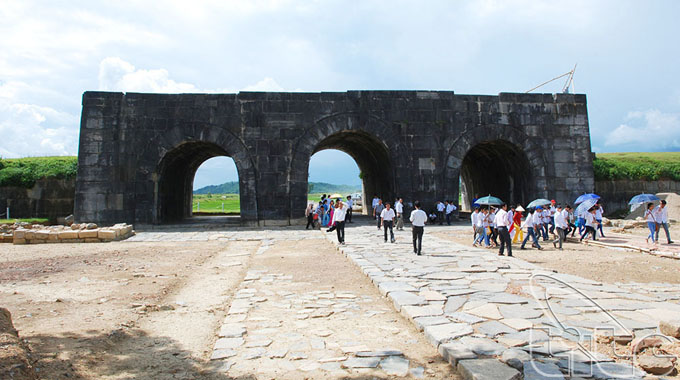(TITC) - The CNN (U.S) has published a list of 21 most beautiful heritage sites in the world, of which Citadel of the Ho Dynasty (Viet Nam) ranks 1st.

The Citadel of the Ho Dynasty belongs to communes of Vinh Tien, Vinh Long, Vinh Quang, Vinh Yen, Vinh Phuc, Vinh Ninh, Vinh Khang, Vinh Thanh and Vinh Loc Town, Vinh Loc District, Thanh Hoa Province.
The Citadel of the Ho Dynasty (the capital citadel of Viet Nam from 1398 to 1407) was built in 1397 by Ho Quy Ly who was the highest-ranking mandarin of the Tran Dynasty at the time. With a total area 5,234ha and including main works of Thanh Noi, Hao Thanh, La Thanh and Nam Giao Altar, Citadel of the Ho Dynasty is the spectacular stone citadel with the combination of Vietnamese traditional and East Asia and Southeast Asia architectures. This is the outstanding example of an architectural complex located among the natural landscapes thanks to the unique construction techniques and the use of sustainable raw materials, especially the large stone sections (each weigh from 15 to 20 tons).
Through ups and downs of history, the architecture of Citadel of the Ho Dynasty is not intact. Currently, Thanh Noi remains only some relics and artifacts, such as: the citadel’s foundation, wall and four gates, Southern gate precinct, a couple of stone dragons with sophisticated carving features, Hoa Nhai marble-paved road, stone balls, stone bullets, pottery, and valuable objects with specific characteristics of Tran - Ho dynasties culture. Hao Thanh has the traces in the north, east and south of the citadel. The trace of La Thanh was found in Beo Village (Vinh Long Commune) with a length of 2,051.9m, a height of about 5m, trapezoid section of 9.2m, the base of the citadel of 37m and has been localized for protection. Nam Giao Altar appears 5 grounds with a difference of 7.80m between the highest and the lowest. This is the place to sacrifice to the heaven; pray for harmonious rain and wind, peaceful country and happy people, prosperous and everlasting dynasty.
Citadel of the Ho Dynasty is surrounded by unique landscapes and relics, such as: Nang Cave and An Ton Mountain, exhibition room of documents, photos on the citadel of Ho Dynasty, Du Anh Pagoda and Ho Cong Grotto, Giang Pagoda, Dong Mon Communal House…
In June 2011, the Citadel of the Ho Dynasty was recognized as World Cultural Heritage Site by UNESCO. The recognized site covers an area of 155.5ha, including 3 architectural works of Thanh Noi (142.2ha), Nam Giao Altar (4.3ha) and a part of La Thanh (9ha).
In addition to the Citadel of the Ho Dynasty, the list of 21 most beautiful heritage sites in the world also includes Easter Island (Chile), Velletta Capital (Malta), Yellowstone National Park (U.S), Bagan Ancient Capital (Myanmar), Goreme National Park and Cappadocia Rock Mountain (Turkey), Angkor (Cambodia), Acropolis Hill (Greece), Petra Ancient Citadel (Jordan), Galapalos Islands (Ecuador), Iguazu National Park (Brazil and Argentina), Greater Barrier Reef (Australia), Hampi Town (India), Los Glaciares National Park (Argentina), Machu Picchu (Peru), Mont-Saint-Michel (France), Pyramid of Giza (Egypt), Serengeti National Park (Tanzania), Sigiriya Lion Mountain (Sri Lanka), the coastal city of Tulum (Mexico), and Venice City (Italy).
Thu Giang